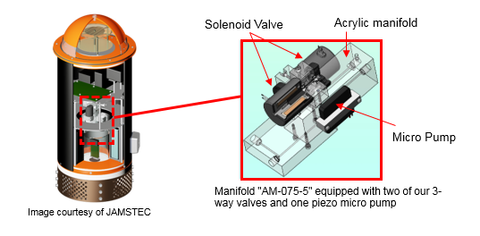- Case Studies
- JAMSTEC Adoption example
JAMSTEC Adoption example
Challenge of miniaturization and power saving. Automatic measurement of CO2 concentration on ocean surface.

Measurement of CO2 on ocean surface
*Images courtesy of JAMSTEC

Inside the CO2 measurement buoy
Japan Agency for Marine-Earth Science and Technology (JAMSTEC) used a ship to monitor the concentration of CO2 on the sea in order to more accurately grasp the distribution of the absorption / release of CO2, one of the greenhouse gases, on a global scale. But they felt the limitations of the conventional method, and developed the "CO2 measurement buoy" to measure while drifting on the ocean surface. Our products are used as part of the core system of flow-cell.
Challenges and Solutions
Conventionally, CO2 measurement device on a ship required several gas cylinders, and the size of the entire device was about 1900 x 1200 x 600 mm. This was unsuitable for equipment that would float on the surface of the ocean for automatic measurements because it was large, heavy, and expensive. Therefore, a new device called "CO2 measurement buoy" was developed. This system uses a pH indicator solution that changes color when the pH (hydrogen ion concentration) changes, such as litmus paper. When CO2 is exchanged with the surrounding seawater through the gas permeable membrane, the pH changes as CO2 moves in and out of the pH indicator solution, and the color of the solution changes. The measuring section calculates the CO2 concentration by measuring the color change of the pH indicator solution in detail, and transmits the data via satellite communication.
We contributed to the miniaturization of the buoy by integrating the micro pump, for sending the pH indicator solution, the valves, for exchanging the solution, and the flow cell, for measuring section, into one manifold. The size of the buoy was reduced to 260 mm in diameter and 600 mm in total length.

Structure of ocean surface carbon dioxide sensor
Takasago product is responsible for sending the pH indicator solution to the gas permeable membrane (tube) and measuring the color (shown by the red broken line).
The completed measuring device contributed to the miniaturization of the CO2 measurement buoy, and succeeded in drifting measurement in the Antarctic Ocean for one year. JAMSTEC praised our strengths in customization and miniaturization and commented as follows, “TFS listened intently at the meeting to make a product that met our specifications. Through numerous phone and email exchanges, they have produced satisfactory products.”.
